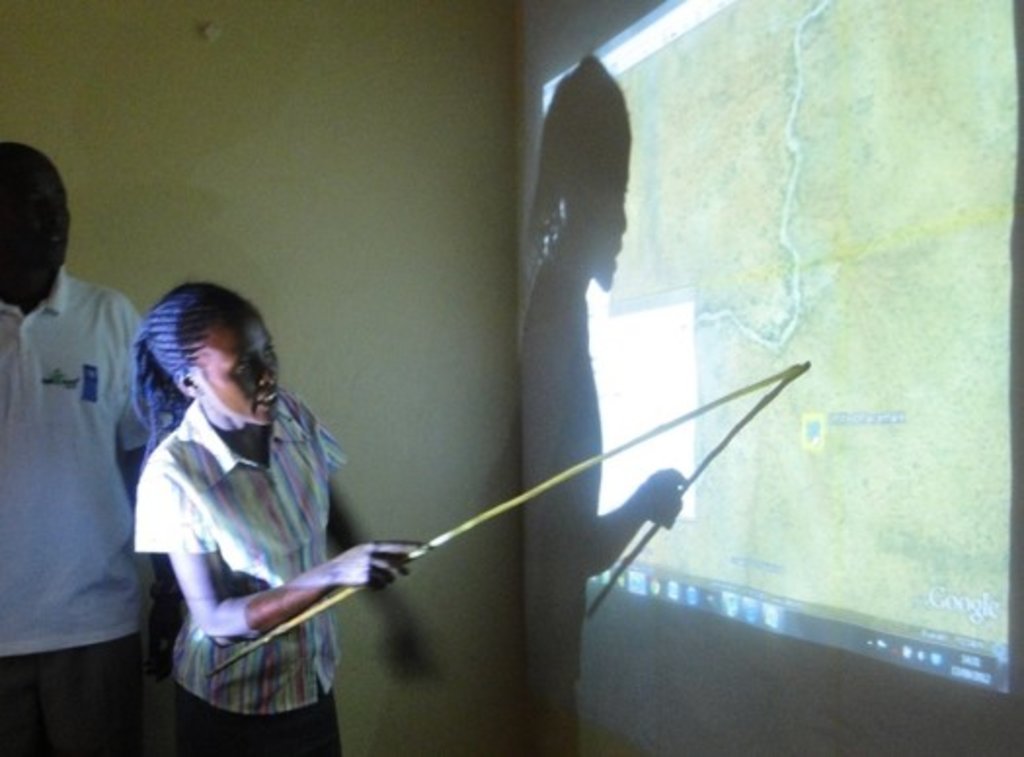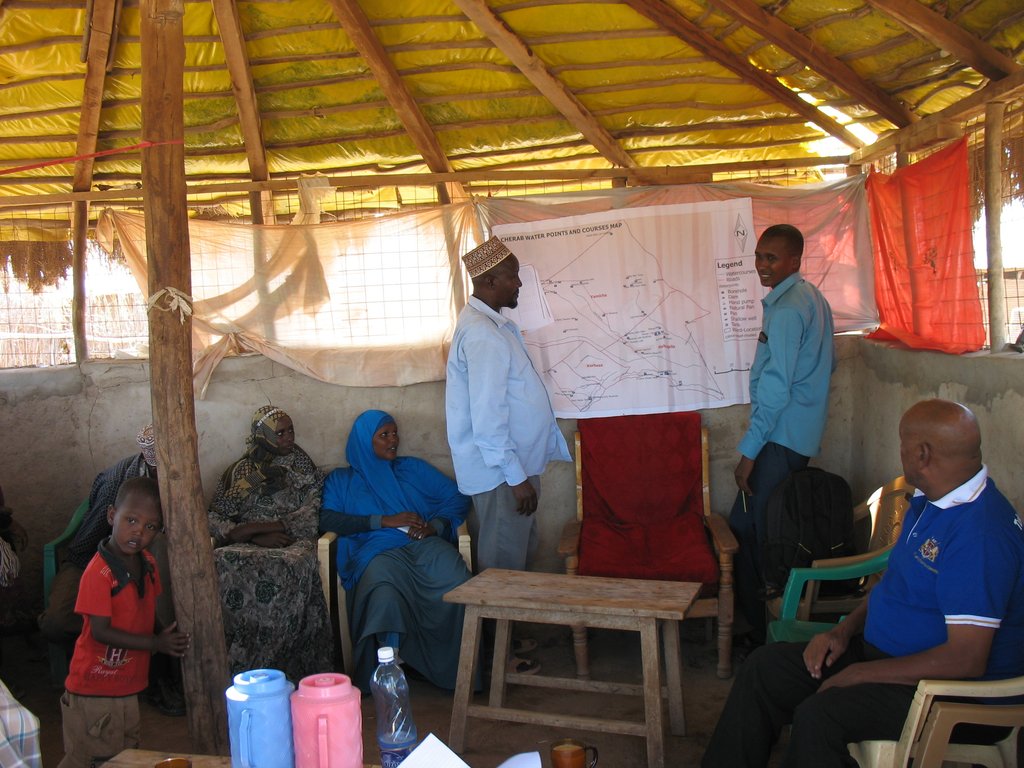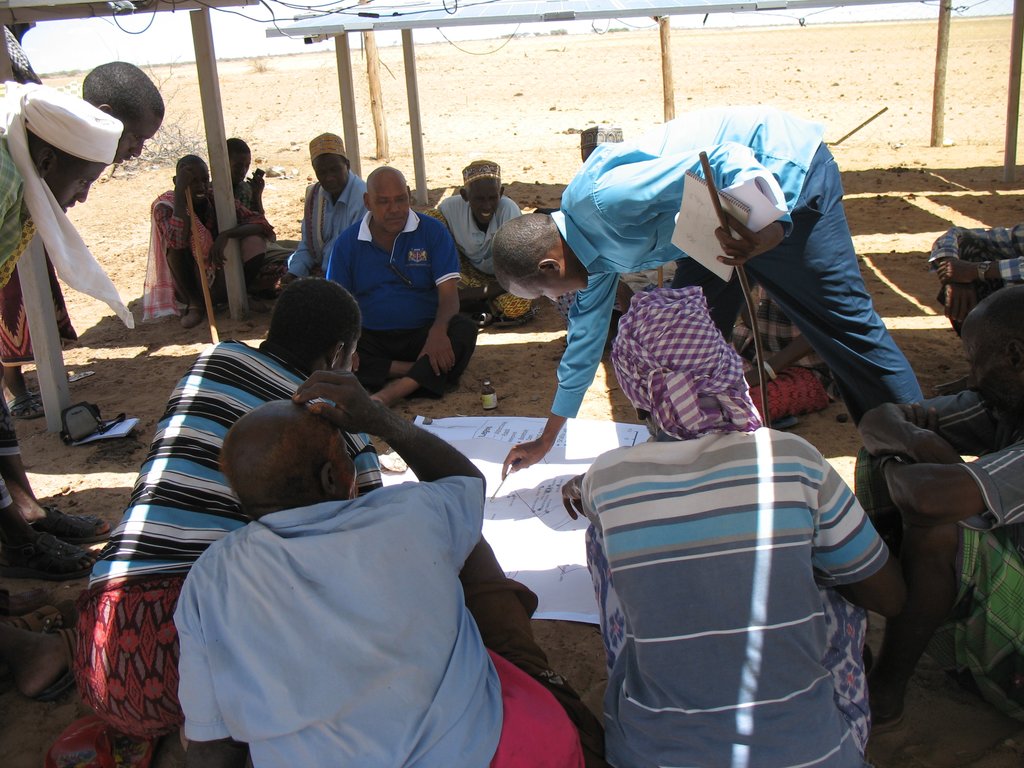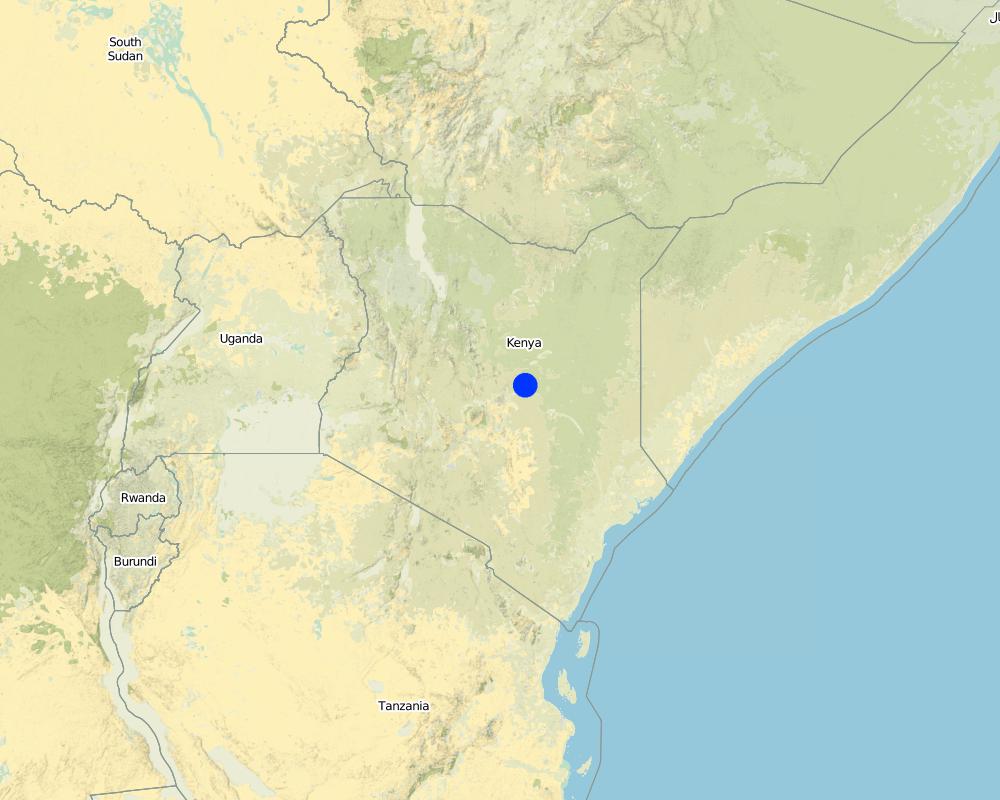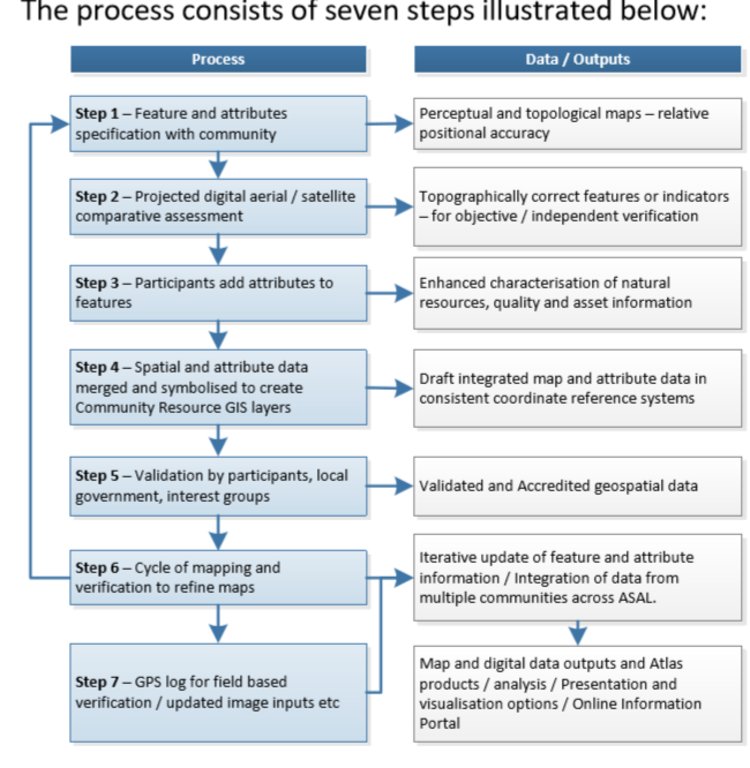Participatory mapping, database building, and monitoring of rangeland resources [Кени]
- Шинийг нээх:
- Шинэчлэх:
- Эмхэтгэгч: IBRAHIM JARSO
- Хянан тохиолдуулагч: Caroline King-Okumu
- Хянагчид: Donia Mühlematter, Rima Mekdaschi Studer, Hanspeter Liniger
Resource Mapping
approaches_3439 - Кени
- Бүрэн хураангуйн PDF хувилбар
- Бүрэн хураангуйг PDF-ээр хэвлэх
- Хөтөч дэх бүрэн хураангуй
- Бүрэн хураангуй (форматгүй)
- Participatory mapping, database building, and monitoring of rangeland resources: 05 7-р сар 2018 (inactive)
- Participatory mapping, database building, and monitoring of rangeland resources: 31 7-р сар 2018 (inactive)
- Participatory mapping, database building, and monitoring of rangeland resources: 05 7-р сар 2018 (inactive)
- Participatory mapping, database building, and monitoring of rangeland resources: 03 9-р сар 2018 (inactive)
- Participatory mapping, database building, and monitoring of rangeland resources: 22 5-р сар 2018 (inactive)
- Participatory mapping, database building, and monitoring of rangeland resources: 13 5-р сар 2018 (inactive)
- Participatory mapping, database building, and monitoring of rangeland resources: 02 11-р сар 2021 (public)
- Participatory mapping, database building, and monitoring of rangeland resources: 19 5-р сар 2018 (inactive)
Бүлгүүдийг үзэх
Бүгдийг дэлгэх Бүгдийг хаах1. Ерөнхий мэдээлэл
1.2 Арга барилыг баримтжуулах болон үнэлгээ хийхэд оролцсон хүн эсвэл байгууллагын холбоо барих хаяг
Газар ашиглагч:
Konsole Hussein
+254 728 064578
saritehussein@yahoo.com
Garbatulla Ward Adaptation Planning Committee
P.O. BOX 1Garbatulla
Кени
Non-State Actor:
Abdullahi Shandey
+254 721109171
midp2003@gmail.com
Merti Integrated Development Program (MID-P)
Merti VillageIsiolo Kenya
Кени
ГТМ мэргэжилтэн:
Арга барилыг баримтжуулах/үнэлэх ажилд дэмжлэг үзүүлсэн төслийн нэр (шаардлагатай бол)
Strengthening Adaptation and Resilience to Climate Change in Kenya Plus (StARCK+)Арга барилыг баримтжуулах/үнэлэх ажилд дэмжлэг үзүүлсэн байгууллага(ууд)-ын нэр (шаардлагатай бол)
Resource Advocacy Programme (RAP) - Кени1.3 WOCAT-аар баримтжуулсан өгөгдлийг ашиглахтай холбоотой нөхцөл
Мэдээллийг хэзээ (газар дээр нь) цуглуулсан бэ?
16/01/2018
Эмхэтгэгч болон гол мэдээлэгч хүн(хүмүүс) WOCAT аргачлалаар баримтжуулсан мэдээллийг ашиглахтай холбоотой нөхцлийг хүлээн зөвшөөрсөн:
Тийм
2. ГТМ Арга барилын тодорхойлолт
2.1 Арга барилын товч тодорхойлолт
Participatory mapping and monitoring of vegetation types and other natural resources in the rangelands. This involves convening stakeholder groups, reviewing conditions of rangeland, water and other resources under changing climatic conditions.
2.2 Арга барилын дэлгэрэнгүй тодорхойлолт
Арга барилын дэлгэрэнгүй тодорхойлолт:
Participatory digital mapping using satellite imagery and digital earth and other open source Geographic Information Systems (GIS) is a practical tool that can bridge knowledge and communication gaps between pastoral communities and county government planners. It offers an effective ‘tool’ for participatory planning and decision-making in support of climate change adaptation efforts in the drylands of Kenya.The use of participatory mapping is not new in seeking to capture communities’ understanding and use of natural resources. These maps are typically drawn on the ground using stones, sticks and other locally available materials to depict key features such as schools, water points, and forest areas, etc. However the process used in Isiolo County combines digital mapping with community-drawn perception maps. This offers a number of extra benefits. While fully capturing the wealth of local knowledge, they contain an in-built coordinate system which corresponds to a global reference grid, enabling their linkage to maps used in formal systems. Furthermore, the coordinate system provides a geographically precise basis from which to discuss natural resource management, making outputs of participatory mapping more universally useable. These benefits, however, need to be carefully balanced to avoid the risk that through this process, pastoral resources – which are highly dynamic - are ‘frozen’ in time and space. Mapping processThe participatory mapping process has adopted GIS workflows within community workshops, enabling the creation of integrated, consistent and standardized geospatial information. The process follows seven steps:Step 1: Community level meetings to develop perception maps drawn on the ground and/or on paper. The product is a community perception map of those resources that are important for their livelihood systems. This map should be created in a community setting to enable the participation of a large group. Several maps may be produced by smaller sub-groups (women, the youth, elders etc) and then amalgamated. The final map is then copied onto paper. Step 2. Digital mapping is introduced. This step takes place in a workshop setting with a smaller group of key informants chosen by the community - as well as county government planners and technical staff. The presence of the latter is critical to the process of ‘legitimizing’ community knowledge. Following a quick explanation of satellite imagery, Google Earth is projected onto a wall alongside the perception maps developed under step 1. The use of Google Earth is only for orientation, and to enable participants to navigate the imagery and to cross-reference their paper-mapped key resources against the satellite imagery. Features that participants feel are important (e.g. water points, wet and dry season grazing areas, drought reserves, wildlife routes) are then captured digitally using open source applications: Quantum GIS (QGIS) and JOSM, the Open Street Map editing platform.This produces the coordinates that pinpoint the locations of natural resources in a manner that can be independently and objectively verified. The highly interactive process of geo-referencing local knowledge to a coordinate reference system allows resource maps to be produced to any scale, and in real-time, with the community. Step 3. Qualitative and quantitative attributes describing the key resources are collected. As participants add features to the map, they also describe their specified characteristics or attributes. Attribution data includes a fuller description of the physical characteristics of the resource (e.g. soil type, waterquantity and quality, pasture species) as well as issues concerning their management (e.g. under customary or modern management, land tenure status, negotiated or paid access, area of conflict). Updating this data on a regular basis adds temporal and trend data to the spatial database. This underlines the need to structure data systems well to manage time-based data and to record updates.Steps 4-6: Data verification cycles are integrated into the mapping process in order to capture community feedback and verify the records in the geospatial data and their attribute values against the specification. The mapping includes a series of validation, cross-checking and verification cycles, run with the community - and in a few instances on-the-ground verification termed ‘groundtruthing’. Step 7: Field validation. Field validation is carried out where the verification stages highlight gaps in information. Verification consists of targeted field visits to take GPS markers, or holding meetings with the local community to clarify particular issues.
2.3 Арга барилын зурагууд
2.5 Арга барил нэвтрүүлсэн улс орон / бүс нутаг / байршил
Улс:
Кени
Улс/аймаг/сум:
Isiolo
Байршлын дэлгэрэнгүй тодорхойлолт:
Pasturalist areas
Map
×2.6 Арга барилыг эхлэх, дуусах огноо
Эхлэх жилийг тэмдэглэ:
2012
Хугацаа дуусах жил (Хэрэв арга барил удаанаар ашиглаагүй бол):
2015
Тайлбар:
The mapping process needs to be continuous as new community resources are identified and added
2.7 Арга барилын төрөл
- төсөл / хөтөлбөр дээр үндэслэсэн
2.8 Арга барилын үндсэн зорилго, зорилтууд
- To allow participation for community groups to inform planners.- To provide the necessary precision for planners to use local knowledge effectively.- To make a ‘bridge’ for information to flow between customary and formal institutions.- To better share ideas through communication tools using powerful visual language.- To demonstrate the depth of local knowledge about natural resources and with that, demonstrate the importance of these resources.- To identify gaps and risks in the system being mapped.- To compare one plan with another to see how complimentary/contradictory they are.
2.9 Арга барилын хүрээнд хэрэгжсэн Технологи/Технологиудад дэмжсэн эсвэл саад учруулсан нөхцлүүд
нийгэм / соёл / шашны хэм хэмжээ, үнэт зүйлс
- Идэвхижүүлэх
Communities are awed by the technology that allows them to see their resources while seated in a single specific location. The approach doesn't conflict with any community social, cultural, religious norms and values.
- Хазаарлалт
Minimal local capacity is required to use the technology.
санхүүгийн нөөц, үйлчилгээний хүртээмж / боломж
- Идэвхижүүлэх
A brief GIS training of four weeks can allow county government staff to develop, add and update the database.
- Хазаарлалт
Short GIS training courses costs around $850 and facilitation of community engagement meetings may be costly to undertake.
Бүтэц зохион байгуулалт
- Идэвхижүүлэх
The approach helps in improving planning at community and government levels, and is accepted by all stakeholders.
- Хазаарлалт
Poor capacity and financial resources can be a challenge.
талуудыг хамтын ажиллагаа/зохицуулалт
- Идэвхижүүлэх
The product of the participatory mapping process is beneficial to all actors and many are willing to engage in implementation of the approach.
- Хазаарлалт
Different mapping initiatives are undertaken by actors with various objectives.
Хууль, эрхзүйн хүрээ (газар эзэмшил, газар, ус ашиглах эрх)
- Идэвхижүүлэх
The approach helps in land use planning and supports regulations meant to improve land governance such as a customary natural resource management bill.
- Хазаарлалт
County governments can develop their own spatial plans, but there are only few initiatives underway to map county resources
Бодлогууд
- Идэвхижүүлэх
Many policies and laws (including the national constitution) support the mapping of resources to improve land use planning.
- Хазаарлалт
Conflicts over land undermines political will.
Газрын засаглал (шийдвэр гаргах, хэрэгжүүлэх, шаардлага)
- Идэвхижүүлэх
The approach allows communities to develop their land use plans for resource utilisation, and digitize them - making the work of land governance easier.
- Хазаарлалт
Competing claims over land and land-based resources in community lands means enforcement of the approach is often challenged. Resources along administrative boundaries are claimed by different communities.
ГТМ-ийн талаарх мэдлэг, техникийн дэмжлэг авах боломж
- Идэвхижүүлэх
New graduates in dryland resource management, and communities' reception of the new technologies, help in acceptance and implementation of the technology.
- Хазаарлалт
58% of the residents of the county (according to the Kenya National Bureau of Statistics socio-economic survey report of 2016) are illiterate and may have difficulties engaging properly with the technology.
зах зээл (материал худалдан авах, бүтээгдэхүүн борлуулах), үнэ
- Идэвхижүүлэх
Free open source programmes are available to digitize local knowledge to geo-referenced products.
- Хазаарлалт
Good programmes for mapping are expensive.
ажлын багтаамж, хүн хүчний нөөц бололцоо
- Идэвхижүүлэх
The technology makes the process simpler and reduces the workload.
- Хазаарлалт
The processes can be tedious because of the paper maps involved, series of validation and verification of features.
3. Оролцогч талуудын оролцоо ба үүргүүд
3.1 Арга барилд оролцогч талууд болон тэдгээрийн үүргүүд
- Орон нутгийн газар ашиглагч / орон нутгийн иргэд
Jarsa Dedha (customary natural resource management institutions) Community Members (i.e. pastoralists).
Jarsa Dedha identify the most knowledgeable elders from different grazing areas to help in identifying features and providing grazing land management plans that are in place. Community members identify features and contribute to the attributes of the features.
- олон нийтэд түшиглэсэн байгууллагууд
Kinna Integrated community based initiative (KICBI)Ward Adaptation Planning Committees
They identify features and also contribute to attributes of the features
- ГТМ-ийн мэргэжилтэн/ хөдөө аж ахуйн зөвлөх
Ibrahim Jarso
Support mapping process and also add new features supporting updates to the products.
- ТББ
Resource Advocacy Program (RAP)Merti Integrated Development Program (MID-P)Adaptation Consortium
Support the mapping process and mobilize communities and stakeholders for the approach to be implemented properly.
- Орон нутгийн захиргаа
Isiolo County Government
Support the mapping process with intention to use product for planning purpose and own the product
- Засгийн газар (шийдвэр гаргагч, төлөвлөгч)
Kenya's National Government
Support the planning process - also with the intention of using the product for planning.
- Олон улсын байгууллага
International Institute for Environment and Development (IIED) and theUniversity of Southampton (Geodata Institute)
Support with funding to implement the approach and also provide technical expertise to undertake GIS processing of data.
Хэрэв хэд хэдэн оролцогч талууд оролцсон бол голлох төлөөлөгчийг зааж өгнө үү:
WAPC , ADA and IIED
3.2 Арга барилын янз бүрийн үе шатанд орон нутгийн газар ашиглагчид / бүлэглэлүүдийг татан оролцуулах
| Орон нутгийн газар ашиглагч / орон нутгийн иргэдийн оролцоо | Хэн оролцсоныг тодорхойлж, үйл ажиллагааг тайлбарлана уу | |
|---|---|---|
| санаачлага/идэвхжүүлэлт | идэвхигүй | Resource Advocacy Programme (RAP) undertook discussions with the local community and also with the county and national government in shaping the idea for the approach. |
| Төлөвлөгөө | интерактив | All stakeholders (community, RAP, ADA, IIED, Geodata and Governments) were engaged in the planning for the implementation of the Approach. |
| Хэрэгжилт | интерактив | Community members and all stakeholders were involved in the implementation of the participatory mapping. |
| Мониторинг/ үнэлгээ | идэвхигүй | The county government and the actors (RAP, ADA and IIED) monitor the participatory mapping database and improves it. |
3.3 Диаграм (хэрэв боломжтой бол)
Тодорхойлолт:
Participatory mapping of community resources has seven steps, which can be summarised under the main groupings of: consultations with the community where key features are identified and mapped on paper; digitization of community identified points by GIS specialists; processing of the data where community identified attributes are incorporated into the data; and feedback sessions for community validation and verification.
Зохиогч:
Ibrahim Jarso
3.4 ГТМ-ийн технологи/технологиуд сонгох шийдвэр
Хэрэгжүүлэх Технологи/Технологиудын сонголтыг хийж шийдвэр гаргасан хүнийг тодорхойлно уу:
- оролцооны зарчмын хэсэг болох бүх холбогдох талууд
Тайлбар:
The process requires inputs from all the relevant stakeholders. The community provide local knowledge of the features, GIS specialists provide technical expertise and the other local stakeholders provide their knowledge and experience of working in the communities for many years.
Шийдвэрийг юунд үндэслэн гаргасан:
- Хувь хүний туршлага ба санал бодол (баримтжуулаагүй)
4. Техникийн дэмжлэг, чадавхи бүрдүүлэх, мэдлэгийн менежмент
4.1 Чадавхи бэхжүүлэх/сургалт
Газар эзэмшигчид / бусад оролцогч талуудад сургалт явуулсан уу?
Тийм
Хэн сургалтанд хамрагдсан бэ:
- Газар ашиглагчид
- хээрийн ажилтан / зөвлөх
Хэрэв шаардлагатай бол хүйс, нас, яс үндэс, гэх мэт. нэмнэ үү:
5 persons trained- One from County Government (Planning Unit), Two from National government (National Drought Management Authority and Kenya Meteorological Department (KMD)) and Two representative of Local NGOs (RAP and MID-P)
Сургалтын хэлбэр:
- Ажил дээр
- курс дамжаа
Хамрагдсан сэвдүүд:
Participatory GIS mapping techniquesInput of data using different platformsUse of GPS devicesValidation of dataData management
Тайлбар:
The training was well done with seminars and practical sessions
4.2 Зөвлөх үйлчилгээ
Газар ашиглагчдад зөвлөх үйлчилгээ авах боломжтой байдаг уу?
Тийм
Зөвлөх үйлчилгээ үзүүлсэн эсэхийг тогтоо:
- Газар ашиглагчийн талбай дээр
Тодорхойлолт / тайлбар:
practical sessions were provided in the field and with communities
4.3 Институцийг бэхжүүлэх (байгууллагын хөгжил)
Арга барилаар дамжуулан институц байгуулагдаж эсвэл бэхжсэн үү?
- Тийм, дунд зэрэг
Байгууллагууд бэхжиж, үүсэн бий болсон түвшин(үүд)-г тодорхойлно уу:
- Орон нутгийн
Байгууллага, үүрэг, хариуцлага, гишүүд гэх мэтийг тайлбарлах:
Local institutions were able to use the maps to advocate for improved planning.
Дэмжлэгийн төрлийг ялга:
- чадавхи бэхжүүлэх / сургалт
Дэлгэрэнгүй мэдээллийг өгнө үү:
Courses/trainings were provided
4.4 Мониторинг ба үнэлгээ
Мониторинг болон үнэлгээ нь арга барилын хэсэг үү?
Тийм
Тайлбар:
inputs were monitored
Хэрэв тийм бол энэ баримт бичиг нь мониторинг, үнэлгээнд ашиглагдахаар зориулагдсан уу?
Тийм
Тайлбар:
It was also used to mapped investments that were done to improve community livelihoods
4.5 Судалгаа
Судалгаа арга барилын хэсэг нь байсан уу?
Тийм
Сэдвийг тодруулна уу:
- Экологи
Дэлгэрэнгүй мэдээллийг өгч, хэн судалгаа явуулсныг бичнэ үү:
Research on vegetation patterns in Isiolo’s rangelands were conducted by the University of Nairobi's Department of Land and Resource Management.
5. Санхүүгийн болон гадаад материаллаг дэмжлэг
5.1 ГТМ-ийн Арга барилын бүрэлдэхүүн хэсгийн жилийн төсөв
Хэрэв жилийн төсөв тодорхойгүй бол хягаарыг тодруулна уу:
- 10,000-100,000
Тайлбар (жнь: санхүүжилтийн гол эх үүсвэр / гол хандивлагчид):
The approach was supported by RAP and IIED under the Adaptation Consortium with funding from UK's Department for International Development (DfID). The budget is used to convene sub-county level meetings and trainings sessions. Many of the participants costs and preparation costs are not covered.
5.2 Газар ашиглагчдад санхүүгийн / материаллаг дэмжлэг үзүүлсэн
Технологи / технологийг хэрэгжүүлэхэд газар ашиглагчид санхүүгийн / материаллаг дэмжлэг авсан уу?
Үгүй
5.3 Тодорхой зардлыг даахад чиглэсэн дэмжлэгт (хөдөлмөрийн хүчийг оролцуулаад)
- Ажил хөдөлмөр
| Ямар талбайн хэмжээнд | Тэтгэмж, урамшууллыг тодорхойлно уу |
|---|---|
| Бүрэн санхүүждэг | Community meetings were supported by the actors in the project (RAP, IIED and Adaptation Consortium). |
- Тоног төхөөрөмж
| Ямар хөрөнгө оруулалт татаасаар олгогдсоныг заана уу | Ямар талбайн хэмжээнд | Тэтгэмж, урамшууллыг тодорхойлно уу |
|---|---|---|
| машин төхөөрөмж | Бүрэн санхүүждэг | Machinery used in the approach was purchased by the actors involved. |
| Багажууд | Tools used in the approach were purchased by the actors involved. | |
Хэрэв газар ашиглагчийн хөдөлмөрийн хүч чухал байсан бол энэ нь аль хэлбэр байсан:
- сайн дурын
Тайлбар:
Communities provided the local knowledge to support the approach.
5.4 Кредит
Арга барилын хүрээнд ГТМ-ийн үйл ажиллагаанд зориулж зээлд хамрагдсан уу?
Үгүй
6. Нөлөөллийн дүн шинжилгээ ба дүгнэлт
6.1 Арга барилын нөлөөллүүд
Арга барил нь орон нутгийн газар ашиглагчдыг чадваржуулах, оролцогч талуудын оролцоог сайжруулсан уу?
- Үгүй
- Тийм, бага зэрэг
- Тийм, зарим
- Тийм, их
Yes, the approach strengthens community rights and management of resources.
Арга барил нь нотолгоонд суурилсан шийдвэр гаргах боломж олгосон уу?
- Үгүй
- Тийм, бага зэрэг
- Тийм, зарим
- Тийм, их
Yes greatly – provided databases that did not previously exist.
Арга барил нь ГТМ-ийн технологийг хэрэгжүүлж, хадгалахад газар ашиглагчдад тусласан уу?
- Үгүй
- Тийм, бага зэрэг
- Тийм, зарим
- Тийм, их
Strengthened the traditional system of management of land.
Арга барил нь ГТМ-ийн зардал хэмнэсэн хэрэгжилт, зохицуулалтыг сайжруулсан уу?
- Үгүй
- Тийм, бага зэрэг
- Тийм, зарим
- Тийм, их
Improved coordination among the partners and enabled monitoring of resource conditions.
Арга барил нь ГТМ хэрэгжүүлэхэд газар ашиглагчдын мэдлэг, чадварыг сайжруулахад хүргэсэн үү?
- Үгүй
- Тийм, бага зэрэг
- Тийм, зарим
- Тийм, их
The technology provided digitized observation of resources, and communities realised their wealth of their resources.
Энэ арга барил бусад сонирхогч талуудын мэдлэг, чадавхийг сайжруулсан уу?
- Үгүй
- Тийм, бага зэрэг
- Тийм, зарим
- Тийм, их
The Community resource atlas of Isiolo County has been online since July 2015.
Yes greatly, the Approach made local institutions stronger and enhanced their collaboration and data sharing.
Энэ арга барил зөрчилдөөнийг багасгасан уу?
- Үгүй
- Тийм, бага зэрэг
- Тийм, зарим
- Тийм, их
The Approach mapped conflict hotspots and improved the process of conflict resolution and analysis.
Арга барил нь жендэрийн тэгш байдлыг сайжруулж, эмэгтэйчүүд, охидыг чадавхжуулсан уу?
- Үгүй
- Тийм, бага зэрэг
- Тийм, зарим
- Тийм, их
The process also engaged women in gathering local knowledge of resources and they made a very considerable contribution to the work.
Арга барил нь газар ашиглагч залуучууд / дараагийн үеийн хүмүүсийг ГТМ-д оролцохыг хөхүүлэн дэмжсэн үү?
- Үгүй
- Тийм, бага зэрэг
- Тийм, зарим
- Тийм, их
The use of GIS fascinated young people and they felt attracted to the process.
Арга барил нь ГТМ-ийн технологийг хэрэгжүүлэхэд саад учруулсан газрын эзэмшил / ашиглах эрхийг сайжруулахад чиглэсэн үү?
- Үгүй
- Тийм, бага зэрэг
- Тийм, зарим
- Тийм, их
The approach guided use of land and also strengthened communities ownership and rights over their land and their available resources.
Арга барил нь ус, ариун цэврийн байгууламжийн хүртээмжийг сайжруулахад хүргэсэн үү?
- Үгүй
- Тийм, бага зэрэг
- Тийм, зарим
- Тийм, их
The approach guided water investments in the community lands and improved placement of water infrastructure.
Арга барил нь эрчим хүчний эх үүсвэр/ илүү тогтвортой ашиглалтад хүргэх үү?
- Үгүй
- Тийм, бага зэрэг
- Тийм, зарим
- Тийм, их
The approach mapped boreholes, and the energy used to extract water from them, as well as encouraging use of clean and green energy.
Арга барил нь газар ашиглагчид уур амьсгалын өөрчлөлтөд дасан зохицох чадварыг дээшлүүлж, уур амьсгалын өөрчлөлттэй холбоотой гамшгийг бууруулах чадавхийг сайжруулсан уу?
- Үгүй
- Тийм, бага зэрэг
- Тийм, зарим
- Тийм, их
The approach concretized the community land use plans and guided proper use of their pasture and water - enhancing the community's capacity to adapt to climate related disasters of drought and floods.
6.2 ГТМ-ийг хэрэгжүүлэх газар ашиглагчидын гол санаачилга
- үйлдвэрлэл нэмэгдсэн
The Approach improved planning and management of resources leading to increased productivity
- Газрын доройтол буурсан
Mapping of Land use plans helped in reducing land degradation.Participatory Mapping Approach was used by International Union for Conservation of Nature (IUCN) to map out degaraded lands in the County and targetted interventions were undertaken with Dedha elders.
- Гамшигийн эрсдэл буурсан
The approach allowed the communities to plan and prepare before disasters happen by identifying fall back areas and mapping them.Flood prone areas, Drought reserves and Conflict hotspots were mapped and deliberate interventions undertaken on addressing this.
- дүрэм журам (торгууль) / сахиулах
The Approach developed Maps which guided the enforcement of the traditional rules and regulations of accessing pasture and water during specific seasons.
- Байгаль орчны ухамсар
The approach mapped key environmental resources like non-gazette forests with opportunity to enhance protection and conservation
- ГТМ-ийн мэдлэг, туршлага дээшилсэн
Supported the traditional systems of management of natural resources
- зөрчилдөөнийг бууруулах
The approach mapped the conflict hotspots in the county with intention to resolve or mitigate conflicts
6.3 Арга барилын үйл ажиллагааны тогтвортой байдал
Газар ашиглагчид арга барилаар дамжуулан хэрэгжүүлсэн арга хэмжээг тогтвортой хадгалж чадах уу (гадны дэмжлэггүйгээр)?
- Тодорхойгүй
Хэрэв үгүй эсвэл тодорхойгүй бол дэлгэрэнгүй тайлбар өгнө үү:
The approach was implemented with support from donors and county government. Although in theory, it could be possible for resource users to auto-finance the Approach, this has not ever happened previously, and many of the resource users are not wealthy. Support is available for devolved development planning and mapping, but as yet this has not been assigned to participatory resource mapping.
6.4 Арга барилын тогтвортой/давуу тал/боломжууд
| Газар ашиглагчдын тодорхойлсон давуу тал/боломжууд |
|---|
| It is a promising new approach that builds on the legitimacy of local/indigenous knowledge, and enables the county government to fulfil its mandate of undertaking participatory planning with communities. |
| GIS technology helps in the acceptance of the approach by many land users. |
| The mobililty of the technology can provide an opportunity for all community members to add features as they come up |
| Эмхэтгэгч, бусад мэдээлэл өгсөн хүмүүсийн өнцгөөс тодорхойлсон давуу тал/боломжууд |
|---|
| It is a user friendly approach accepted and recognized by Isiolo pastoralists for mapping their rangeland resources. |
| It provides an opportunity to map all investments of development partners in the county and avoid duplication of projects. |
| It is a powerful tool for communication and advocacy for community land rights. |
6.5 Арга барилын дутагдалтай/сул тал/аюул болон тэдгээрийн хэрхэн даван туулах арга замууд
| Газар ашиглагч нарын тодорхойлсон сул тал/ дутагдал/ эрсдэл | Тэдгээрийг хэрхэн даван туулах вэ? |
|---|---|
| It requires time and commitment from community members and county officers. | Systematic use of media (e.g. radio, websites, etc) to publicize the approach and its importance to the community. |
| It is difficult for illiterate community members to fully engage with the approach and make meaningful contributions. | Provide local translations and interpretation as well as producing good visual maps. |
| Эмхэтгэгч, бусад мэдээлэл өгсөн хүмүүсийн өнцгөөс тодорхойлсон сул тал/ дутагдал/ эрсдэл | Тэдгээрийг хэрхэн даван туулах вэ? |
|---|---|
| There is a need for continuous updating | Engage local universities and students. |
| Observation of key features and resources are sometimes obscured by clouds and thus mapping precision is affected. | Ground truthing visits and observations need to be undertaken to improve precision. |
| Lack of legislation to support and enforce the use of the approach. | Formulate legislation to support enforcement. |
7. Суурь мэдээлэл болон холбоосууд
7.1 Мэдээллийн эх үүсвэр/аргууд
- Хээрийн уулзалт, судалгаа
Made 2 field visits in Kinna and Garbatulla Wards, engaged 20 community members
- Газар ашиглагчтай хийсэн ярилцлага
20 community members and 3 community based organization representatives
- ГТМ-ийн мэргэжилтэн/шинжээчтэй хийсэн ярилцлага
Engaged 2 staff of MID-P and 2 staff of RAP
- тайлан болон бусад эх сурвалжийн бүрдэл
used Community Resource Mapping and Validation reports and Isiolo Community Resource Atlas 2015
7.2 Холбогдох бүтээлийн ишлэл
Гарчиг, зохиогч, он, ISBN:
Participatory Mapping using Digital Earth Tools, Imagery and Open Source GIS in the drylands of Kenya and Tanzania by Chris Hill, Tom Rowley, Homme Zwaagstra, Andrew Harfoot and Mike Clark
Хаанаас авч болох вэ? Зардал?
Ada Consortium Website
7.3 Холбогдох мэдээллийн интернет дэх нээлттэй холбоосууд
Гарчиг/ тодорхойлолт:
Resource Atlas of Isiolo County, Kenya
URL:
pubs.iied.org/pdfs/G03984.pdf
Холбоос ба модулууд
Бүгдийг дэлгэх Бүгдийг хаахХолбоосууд
Холбоос байхгүй байна
Модулууд
Модуль байхгүй байна



